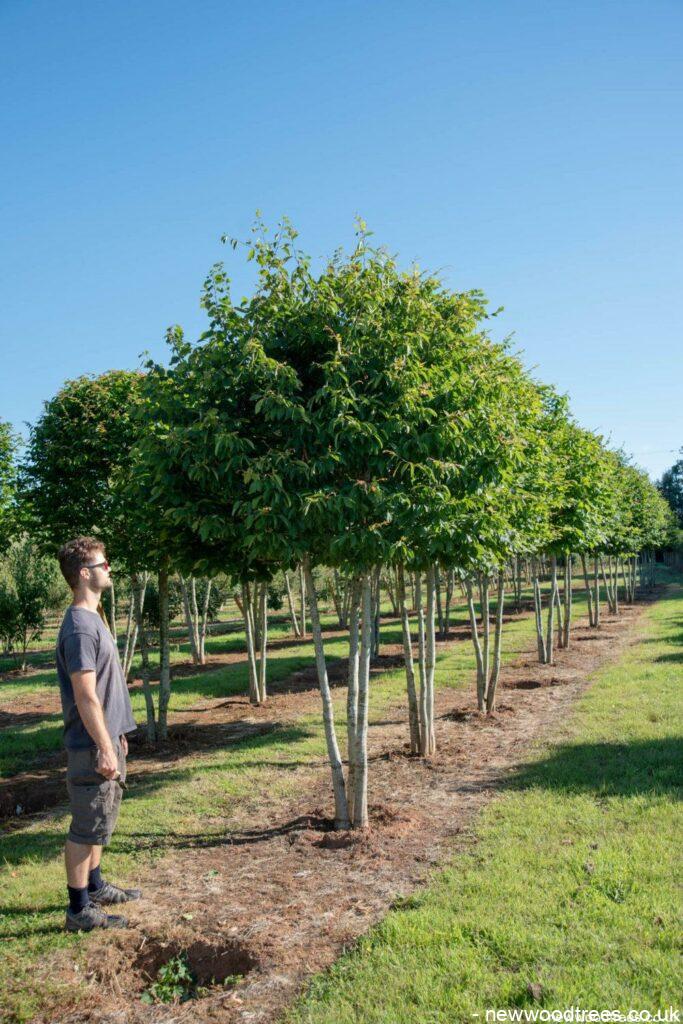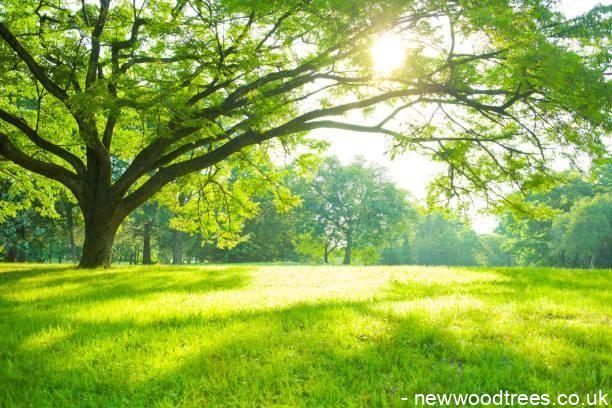Trees are potent and vital anchors in our outdoor spaces, setting the tone and ambience anywhere within a garden. However, how do you position trees in a garden for maximum impact? The position of trees in a garden can involve meticulous alignment of aesthetics with underlying botanical needs.
Beyond immediate aesthetics, the spatial interplay of branches through sunlight and shadow co-creates experiences for gardening’s true stars – the people inhabiting them. So thoughtful positioning and orientation ensure these woody sentinels become horticultural highlights for years.
Let’s explore essential factors guiding the careful positioning of trees within a garden. Considerations like scale, canopy, space, purpose, and plant personalities all shape different paradigms for planting these mighty elements within a landscape.
How Do You Position Trees In A Garden? Our Top Tips
- Assessing Scale and Size
The most immediate factor when positioning a tree is assessing and envisioning its ultimate stature. Dwarfed trees such as a strawberry tree may seem spaciously distant at planting, then twenty years later, suddenly loom, shade, or intrude without prudent planning. Will gangly limbs eventually impede paths, swallow seating areas, or envelop the house facades after decades of growth?
This means making sure your plans on paper include the potential tree height, canopy spread, and root space. Anticipating these spatial boundaries helps balance future shade needs versus overcrowding issues. You don’t want the eaves of buildings smothered by an aggressive tree canopy, for example, or your trees dominating the prominence of a house or delicate garden plants engulfed by greedy roots.
Some tree species feature columnar (upright) growth habits, with secondary boughs jutting horizontally. This helps conserve space while managing shade spread through architectural precision. Other standard trees usually grow broader than tall, so lateral versus vertical considerations dominate positioning these pillars. Knowing growth tendencies helps position trees thoughtfully.
You can get large trees for sale, such as the Italian Alder, from reputable nurseries, landscaping suppliers, or specialised tree farms offering diverse species and sizes to suit your specific aesthetic and environmental considerations.
- Maximizing Canopy Shade Benefits
Gardens exist as important areas for communing with nature, friends and family.
So, appraising and mapping daily shade swatches across the area helps target prime positioning for trees based on usage zones within the garden and their future overlaying canopies. Like natural parasols, the arcing trajectories of dappled light and shadowed refuge shift progressively from hour to hour as seasons also paint different intensity gradients.
For patio seating or private retreats you want in the shade, situate new tree plantings purposefully south or west of these spaces based on sun angles and the right eventual growth scale. This parasol effect also shelters plants, pets, or structures vulnerable to direct sun exposure.
If you specifically want to buy trees with privacy in mind, you can search for trees for sale near me or tree nurseries near me and choose the type of tree that suits your preference. For instance, Hornbeam, Pines or Yew provide excellent screening. We grow carpinus betulus as a multi-stem tree with a canopy pruned to the same height as most fences, and even as a deciduous tree it still retains many of its leaves over winter.

- Defining or Enhancing Spaces
Trees such as the White Chinese Birch also perform critical space definition functions through vertical mass that can embrace, reveal, or partition the garden. Since they are smaller, they can fit into smaller spaces. Arranging clusters or standalone sentinels creates outdoor ‘rooms’ that invite relaxation, dining, and gathering while being shielded from wider expanses. This human-scale enclosure stimulates that cozy Christmas Eve feeling of snuggling indoors against the howling elements.
Frame particular views through vista portals, guide visitors via alluring pathways, or build privacy barriers against prying eyes or harsh winds with deliberate botanical backdrops. Evergreen trees help with privacy all year round; deciduous trees filter the summer sun and then unveil winter light. Careful curation with trees as primary monomers constructs the garden’s overall vibe, whether formal, rambling, or secretive.
Consider the visual proportions and distances of trees from the house, too, so their scale complements rather than overpowers.
- Matching Purpose and Personality
While their protective blessings keep us happy, trees pursue their pleasures, too, as any pet owner would understand. Certain trees, such as the Japanese strawberry tree, relish ample space or complicated roots below. Others thrive solitarily, soaking maximum light, while some happily socialise to share soil or pollination.
Seeking symbiosis means selecting species aligned to site conditions – parched slopes, damp hollows, acidic or compacted soils, each flatter some more than others. Understand each tree’s natural affinities and environmental cousins so the right plants feel nurtured for long-term health. Happier trees mean happier gardeners.
By matching the type of tree you can also plan to avoid costly problems that might occur if you have several varieties in the same space; some trees can have aggressive surface roots which crack pavements, others might create intrusive shade which suppresses solar panels, or drop leaves leaving gutters clogged.
Positioning trees for everyone’s comfort and compatibility minimises conflict, maintenance hassles or productivity disruptions. It also honours botanic etiquette – would you camp your stretching willow or Norway maple right where a sun-loving fruit orchard will starve?

- Striving for Balance
A common temptation exists, placing mighty trees dead centre as imposing arboreal centrepieces presiding sternly over the garden. Just like a symmetrically centred fireplace can make a living room feel awkward to use, trees positioned as overpowering centrepieces reduce the enjoyment for people in the garden. It is possible to have too much of a good thing.
Instead, think of equilibrium and harmony. Position core tree anchors among supporting shrubs and herbs to nourish a diversity of guests, from resident birds to beneficial pollinators to our kin seeking multi-sensory delights.
Counterpoise open and enclosed spaces, framed views against sweeping vistas, and shaded nooks against sunny patches so people feel embraced regardless of mood or mobility. Build the garden as a flexible experiential ecosystem with invitational spaces flowing into more secluded private niches.
For immediate impact in landscape design, you can get mature trees for sale, such as the Field Maple, which will transform your outdoor space into a lush and well-established environment that immediately adds beauty, shade, and a sense of maturity to your surroundings.
- The Human Dimension Rules
Ultimately, gardens exist for people, not plants, no matter how attracted we become by bewitching botanicals. So, pragmatically position trees for maximising human enjoyment first. Shape space for hosting, gathering, playing or meandering aligned to patterns of family living rather than abstract ideals. After all, the happiest trees arise when people feel nurtured to spend quality time among them. Additionally, if you want some colour in your garden, you can get trees like the Purple Leafed Smoke Bush.
Furthermore, always consider – how will visitors or I feel here at different times of day or year, alone versus together? Will access still be easy when I’m older and less mobile many years from now? Will this corner be a nice spot for outdoor dining or cosy winter gatherings around the fire? Are the tree branches high enough for kids to build a play fort safely? And does the layout welcome local wildlife like squirrels looking for places to store food?
Arrange plants through emotional Intelligence as much as Environmental Science. Final positioning equates to curating experiences, not just biological necessities. Thoughtfully balancing shading, structural definition, scale and variety optimises garden spaces for human comfort. Then happy people cultivate happy plants in reciprocity that nourishes everyone’s spirits.
- Considering Maintenance Accessibility
When deciding where to position trees in a garden, it’s essential to consider future pruning, watering, and care requirements. Don’t block pathways and access routes around trees that will later be needed to transport ladders or other equipment. Trees like the River Birch create such a beautiful canopy tree.
Moreover, leave enough clearance in front and behind to enable workers to safely move around the tree canopy with chainsaws or other tools during maintenance. Positioning trees right against fences, buildings, walls, or other obstructions may seem aesthetically pleasing initially but sets up significant hazards or obstacles for essential garden maintenance later.
- Planning Drainage
Understand the drainage profile and flow patterns of your space when situating trees. Avoid placing them in perpetually flooded zones at basin collection points. But equally, prevent uncontrolled storm runoff from eroding exposed roots on slopes by careful flow diversion or planting on contour terraces. Proper drainage planning preserves long-term tree vigour and stability while preventing infrastructure damage from landslips or floods.
In addition to considering the drainage profile and flow patterns of your garden when planting trees, paying attention to the soil composition and moisture levels is crucial. Different tree species have varying preferences for soil types and drainage conditions. For instance, the Paperbark maple is a slow-growing tree; therefore, it can easily be grown in a container, which makes it easier to control the drainage in your garden.
Therefore, conducting a soil analysis can help determine the soil’s nutrient content and drainage capabilities, allowing you to choose trees well-suited to your site’s specific conditions. Adequate soil preparation, such as amending soil texture and structure, can further enhance water drainage and promote optimal root development.
- Incorporating Creative Support Solutions
For trees such as Tibetan cherry situated in lawn spaces subject to mower or foot traffic damage or to guide people away from tricky surface roots, decorative solutions like benches, garden beds, or fencing around the tree pit zone offer possibilities.
These can act as protective buffers while adding ornamental interest or habitat for other creatures to enjoy. With creative vision, tree protections can boost aesthetics rather than detract from them. The Japanese Privet has clusters of white flowers that boost the overall aesthetics.
Conclusion
Where you position trees in a garden has a big impact – it shapes the space and what people, animals, and plants will experience there. Beyond blossoms and fruit, trees sculpt space by tracing tangled roots downward while branching skyward to interlace air, light, and life-giving precipitation in leafy abundance.
Carefully planting trees fulfils important duties as environmental stewards. But thoughtfully placing trees with people’s enjoyment in mind is even more important. It encourages health, sparks creativity, and brings people together. Crafting gardens where plants, wildlife and humans can prosper together should be the goal for skilled garden planners.






